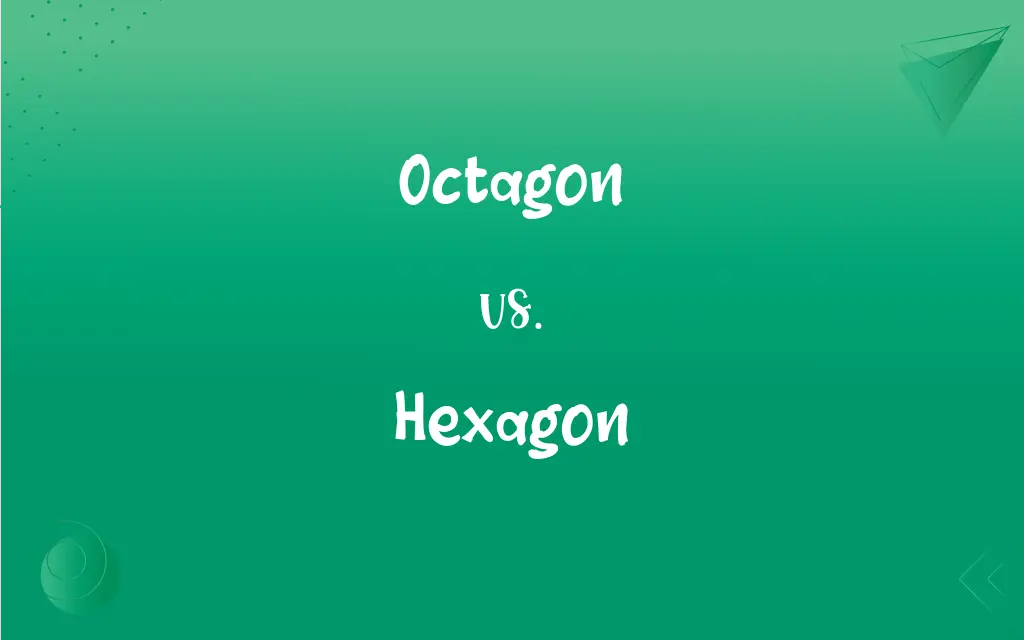Octagon vs. Hexagon: What's the Difference?
By Harlon Moss & Janet White || Updated on March 4, 2024
An octagon is an 8-sided polygon, whereas a hexagon is a 6-sided polygon, differing in sides and internal angles.

Key Differences
An octagon, defined by its eight sides and eight angles, is a geometric shape commonly recognized in various symbols and structures, such as stop signs. Each internal angle in a regular octagon (where all sides and angles are equal) measures 135 degrees. On the other hand, a hexagon is characterized by its six sides and angles, with each internal angle of a regular hexagon measuring 120 degrees. This difference in the number of sides and internal angles significantly affects their geometric properties and symmetry.
While octagons can be regular or irregular, with regular octagons having all sides and angles equal, hexagons often appear in nature in their regular form, exemplified by honeycomb patterns. The regular octagon is known for its symmetry and balance, used in architectural designs for its aesthetic appeal. Conversely, the regular hexagon is celebrated for its efficiency and structural strength, notably in the construction of beehives, where it optimizes space and material use.
In terms of tiling and partitioning a plane, a regular hexagon uniquely fits with others of its kind without leaving gaps, enabling a compact and efficient arrangement. This property is widely utilized in tessellations and paving designs. However, regular octagons cannot tessellate by themselves but are often paired with squares or other shapes to create a tessellated pattern, demonstrating a versatile approach to design and spatial organization.
The geometric construction of these polygons also differs; constructing a regular octagon requires a more complex division of a circle into eight equal parts, whereas a regular hexagon can be constructed by simply joining the endpoints of six equal radii dividing a circle into six parts. This relative simplicity makes the hexagon a more accessible shape for educational purposes and practical applications.
In the field of symbolism and meaning, octagons are often associated with regeneration and transition, reflecting their broader sides and angles. In contrast, hexagons symbolize harmony and balance, mirroring their prevalence in natural formations and their efficiency in design. This symbolic representation influences their use in art, culture, and design, reflecting the inherent qualities and perceptions of each shape.
ADVERTISEMENT
Comparison Chart
Sides
8
6
Internal Angles
135 degrees (regular)
120 degrees (regular)
Symmetry
8-fold for regular octagons
6-fold for regular hexagons
Tiling Capability
Cannot tessellate alone; needs other shapes
Can tessellate by itself without gaps
Natural Occurrences
Less common in nature
Common in nature (e.g., honeycomb structure)
ADVERTISEMENT
Geometric Construction
More complex division of a circle
Simpler, using six equal radii of a circle
Symbolism
Represents regeneration, transition
Symbolizes harmony, balance
Applications
Architecture (e.g., stop signs), design
Nature (e.g., beehives), tessellation, design
Octagon and Hexagon Definitions
Octagon
Can have both regular (equal sides and angles) and irregular forms.
An irregular octagon does not have equal sides.
Hexagon
A six-sided polygon prevalent in nature and design.
Honeycombs are made of hexagonal cells.
Octagon
A polygon with eight sides and angles.
A stop sign is shaped like a regular octagon.
Hexagon
Regular hexagons have equal sides and angles, offering structural efficiency.
Hexagonal paving stones fit together without gaps.
Octagon
Often used in architectural design for its aesthetic appeal.
Octagonal towers in castles.
Hexagon
Symbolizes harmony and balance, inspired by its natural occurrences.
Hexagonal snowflakes represent natural symmetry.
Octagon
Requires a complex geometric construction for its regular form.
Dividing a circle into eight equal parts to construct a regular octagon.
Hexagon
Can tessellate by itself, optimizing space in patterns and designs.
Hexagonal tiles in a bathroom floor.
Octagon
Symbolizes regeneration and transition in various cultures.
Octagonal patterns in religious art.
Hexagon
Simpler to construct geometrically than an octagon.
Drawing six equal radii from a circle’s center to form a hexagon.
Octagon
A polygon with eight sides and eight angles.
Hexagon
A polygon with six sides and six angles.
Octagon
A polygon with eight sides and eight angles.
Hexagon
(geometry) A polygon with six sides and six angles.
Octagon
(martial arts) Often in the form Octagon: the arena for mixed martial arts.
Hexagon
A plane figure of six angles.
Octagon
A plane figure of eight sides and eight angles.
Hexagon
A six-sided polygon
Octagon
Any structure (as a fortification) or place with eight sides or angles.
Octagon
An eight-sided polygon
FAQs
What is an octagon?
An octagon is a polygon with eight sides and eight angles, which can be regular (all sides and angles equal) or irregular.
How do octagons and hexagons differ in geometry?
Octagons have eight sides and typically larger internal angles (135° in regular octagons) compared to hexagons, which have six sides and 120° internal angles in regular forms.
What is a hexagon?
A hexagon is a six-sided polygon, famous for its regular form in nature, like honeycomb structures, with equal sides and angles.
Can both octagons and hexagons tessellate?
Hexagons can tessellate by themselves, fitting together without gaps, while octagons require additional shapes like squares for tessellation.
Where are hexagons found in nature?
Hexagons are commonly found in nature, such as in the structure of honeycombs, showcasing efficient space use and structural strength.
What does a regular octagon symbolize?
A regular octagon often symbolizes regeneration and transition, reflecting its broader sides and angles in various cultural and artistic contexts.
What role do hexagons play in beekeeping?
In beekeeping, hexagons are crucial due to their presence in the natural structure of beehives, where they provide efficient space usage and structural stability.
Why are hexagons considered efficient in design?
Hexagons are considered efficient because they can pack together without wasting space, making them ideal for tessellations and structures like beehives.
What are the applications of octagons in design?
Octagons are used in various design applications, including architecture (e.g., stop signs, octagonal towers) and symbolic art, due to their aesthetic appeal and symbolic meanings.
How are hexagons used in paving and tiling?
Hexagons are popular in paving and tiling due to their ability to tessellate perfectly, creating compact and aesthetically pleasing designs.
Why are octagons used for stop signs?
Octagons are used for stop signs primarily for their high visibility and the association of their shape with stopping, enhancing safety and recognition.
What symbolism is associated with hexagons?
Hexagons are associated with harmony and balance, inspired by their efficiency and prevalence in natural formations.
Can octagons be found in nature?
While less common than hexagons, octagonal patterns can occasionally be observed in nature, though they are more frequently created by human design.
Are all octagons and hexagons regular?
Not all octagons and hexagons are regular; they can be irregular with unequal sides and angles, but regular forms are more symmetrical and aesthetically pleasing.
What practical applications do hexagons have in engineering?
In engineering, hexagons are used in materials and structures that require strength and efficiency, such as in composite materials and packing problems.
What makes octagons and hexagons unique in geometry?
Their uniqueness lies in their number of sides and internal angles, affecting their symmetry, tessellation capabilities, and applications in design and nature.
How do internal angles differ between octagons and hexagons?
Regular octagons have internal angles of 135 degrees, whereas regular hexagons have internal angles of 120 degrees, affecting their shape and properties.
How is the construction of a regular octagon different from a hexagon?
Constructing a regular octagon is more complex, requiring the division of a circle into eight parts, while a hexagon can be constructed by dividing a circle into six equal parts.
How do octagons and hexagons compare in terms of symmetry?
Both shapes exhibit symmetry, but regular octagons have 8-fold symmetry while regular hexagons have 6-fold symmetry, reflecting their number of sides.
Why might a designer choose an octagon over a hexagon for a project?
A designer might choose an octagon over a hexagon for its aesthetic appeal, symbolic meaning, or to fulfill specific design requirements that benefit from its geometric properties.
About Author
Written by
Harlon MossHarlon is a seasoned quality moderator and accomplished content writer for Difference Wiki. An alumnus of the prestigious University of California, he earned his degree in Computer Science. Leveraging his academic background, Harlon brings a meticulous and informed perspective to his work, ensuring content accuracy and excellence.
Co-written by
Janet WhiteJanet White has been an esteemed writer and blogger for Difference Wiki. Holding a Master's degree in Science and Medical Journalism from the prestigious Boston University, she has consistently demonstrated her expertise and passion for her field. When she's not immersed in her work, Janet relishes her time exercising, delving into a good book, and cherishing moments with friends and family.































































